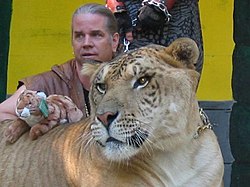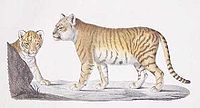Thành viên:Unpear/Liger
| Unpear/Liger | |
|---|---|
 Liger đực (phải) và cái (trái) | |
| Phân loại khoa học | |
| Giới (regnum) | Animalia |
| Ngành (phylum) | Chordata |
| Lớp (class) | Mammalia |
| Bộ (ordo) | Carnivora |
| Họ (familia) | Felidae |
| Chi (genus) | Panthera |
| Loài (species) | Panthera leo × Panthera tigris |
| Danh pháp hai phần | |
| không có | |
Sư hổ hay Liger là con lai giữa một con sư tử đực (Panthera leo) và một con cọp cái (Panthera tigris), do đó, cha mẹ của chúng cùng chi nhưng khác loài. Cần phân biệt chúng với hổ sư (tiglon), con lai giữa cọp đực và sư tử cái. Chúng là loài lớn nhất trong số các loài họ mèo đã biết.
Như loài cọp, sư hổ thích bơi trông khi chúng cũng có tính bầy đàn như sư tử, nhưng không giống như hổ sư, ligers are more likely to live past birth. However ligers may inherit health issues or behavioural issues due to conflicting inherited traits, but this depends on the genetic traits of the parents. Ligers exist only in captivity because the parental species do not overlap naturally in range. Ligers typically grow as large as both parents put together.
History
[sửa | sửa mã nguồn]The history of ligers dates to at least the early 19th century in, India Asia. In 1799, Étienne Geoffroy Saint-Hilaire (1772–1844) made a colour plate of the offspring of a lion and a tiger.
In 1825, G.B. Whittaker made an engraving of liger cubs born in 1824.[cần dẫn nguồn] The parents and their three liger offspring are also depicted with their trainer in a 19th Century painting in the naïve style.
Two liger cubs which had been born in 1837 were exhibited to William IV and to his successor Victoria. On 14 December 1900 and on 31 May 1901, Carl Hagenbeck wrote to zoologist James Cossar Ewart with details and photographs of ligers born at the Hagenbeck's Tierpark in Hamburg in 1897.
In Animal Life and the World of Nature (1902–1903), A.H. Bryden described Hagenbeck's "lion-tiger" hybrids:
It has remained for one of the most enterprising collectors and naturalists of our time, Mr. Carl Hagenbeck, not only to breed, but to bring successfully to a healthy maturity, specimens of this rare alliance between those two great and formidable felidae, the lion and tiger. The illustrations will indicate sufficiently how fortunate Mr. Hagenbeck has been in his efforts to produce these hybrids. The oldest and biggest of the animals shown is a hybrid born on the 11th May, 1897. This fine beast, now more than five years old, equals and even excels in his proportions a well-grown lion, measuring as he does from nose tip to tail 10 ft 2 inches in length, and standing only three inches less than 4 ft at the shoulder. A good big lion will weigh about 400 lb [...] the hybrid in question, weighing as it does no less than 467 lb, is certainly the superior of the most well-grown lions, whether wild-bred or born in a menagerie. This animal shows faint striping and mottling, and, in its characteristics, exhibits strong traces of both its parents. It has a somewhat lion-like head, and the tail is more like that of a lion than of a tiger. On the other hand, it has no trace of mane. It is a huge and very powerful beast.[1]
In 1935, four ligers from two litters were reared in the Zoological Gardens of Bloemfontein, Nam Phi. Three of them, a male and two females, were still living in 1953. The male weighed 340 kg (750 lb) and stood a foot and a half (45 cm) taller than a full grown male lion at the shoulder.
Although ligers are more commonly found than tiglons today, in At Home In The Zoo (1961), Gerald Iles wrote "For the record I must say that I have never seen a liger, a hybrid obtained by crossing a lion with a tigress. They seem to be even rarer than tigons."[2]
Size and growth
[sửa | sửa mã nguồn]The liger is the largest known big cat in the world.[3] Imprinted genes may be a factor contributing to huge liger size.[4] These are genes that may or may not be expressed on the parent they are inherited from, and that occasionally play a role in issues of hybrid growth. For example, in some dog breed crosses, genes that are expressed only when maternally-inherited cause the young to grow larger than is typical for either parent breed. This growth is not seen in the paternal breeds, as such genes are normally "counteracted" by genes inherited from the female of the appropriate breed.[5]
Other big cat hybrids can reach similar sizes; the litigon, a rare hybrid of a male lion and a female tiglon, is roughly the same size as the liger, with a male named Cubanacan (at the Alipore Zoo in India) reaching 800 lbs.[6] The extreme rarity of these second-generation hybrids may make it difficult to ascertain whether they are larger or smaller, on average, than the liger.
It is erroneously believed that ligers continue to grow throughout their lives due to hormonal issues. It may be that they simply grow far more during their growing years and take longer to reach their full adult size. Further growth in shoulder height and body length is not seen in ligers over 6 years old, same as both lions and tigers. Male ligers also have the same levels of testosterone on average as an adult male lion, yet are azoospermic in accordance with Haldane's rule. In addition, female ligers may also attain great size, weighing approximately 320 kg (705 lb) and reaching 3,05 m (10 ft) long on average, and are often fertile. In contrast, pumapards (hybrids between pumas and leopards) tend to exhibit dwarfism.
Ligers are the same size as the prehistoric American lion.

Hercules and Sinbad
[sửa | sửa mã nguồn]Jungle Island, an interactive animal theme park in Miami, is home to a liger named Hercules, the largest non-obese liger, who is recognized by the Guinness Book of World Records as the largest living cat on Earth, weighing over 410 kg (904 lb).[7] Hercules was featured on the Today Show, Good Morning America, Anderson Cooper 360, Inside Edition and in a Maxim article in 2005, when he was only 3 years old and already weighed 408,25 kg (900 lb). Hercules seems completely healthy and is expected to live a long life. The cat's breeding is said to have been a complete accident. Sinbad, another liger, was shown on the National Geographic Channel. Sinbad was reported to have the exact weight of Hercules. Hercules and Sinbad belong to the T.I.G.E.R.S. family of animal ambassadors, who put on the "Tale of the Tiger" show on Jungle Island every day.
Longevity
[sửa | sửa mã nguồn]Shasta, a ligress (female liger) was born at the Hogle Zoo in Salt Lake City on May 14, 1948 and died in 1972 at age 24. The 1973 Guinness world records reported an 18-year-old, 798 kg (1.759 lb) male liger living at Bloemfontein zoological gardens, South Africa in 1888 (it is unclear whether these statements are accurate, as there are claims the liger was 756 lbs and the year was actually 1953). Valley of the Kings animal sanctuary in Wisconsin had a male liger named Nook who weighed around 550 kg (1.213 lb), and died in 2007, at 21 years old. Hobbs, a male liger at the Sierra Safari Zoo in Reno, Nevada, lived to almost 15 years of age before succumbing to liver failure and weighed in at 900 lbs.
Fertility
[sửa | sửa mã nguồn]The fertility of hybrid big cat females is well-documented across a number of different hybrids. This is in accordance with Haldane's rule: in hybrids of animals whose sex is determined by sex chromosomes, if one sex is absent, rare or sterile, it is the heterogametic sex (the one with two different sex chromosomes e.g. X and Y).
According to Wild Cats of the World (1975) by C. A. W. Guggisberg, ligers and tiglons were long thought to be sterile: In 1943 ,a fifteen-year-old hybrid between a lion and an 'Island' tiger was successfully mated with a lion at the Munich Hellabrunn Zoo. The female cub, though of delicate health, was raised to adulthood.[8]
Colors
[sửa | sửa mã nguồn]
Ligers have a tiger-like striping pattern on a lion-like tawny background. In addition they may inherit rosettes from the lion parent (lion cubs are rosetted and some adults retain faint markings). These markings may be black, dark brown or sandy. The background color may be correspondingly tawny, sandy or golden. In common with tigers, their underparts are pale. The actual pattern and color depends on which subspecies the parents were and on how the genes interact in the offspring.
White tigers have been crossed with lions to produce "white" (actually pale golden) ligers. In theory white tigers could be crossed with white lions to produce white, very pale or even stripeless ligers. A black liger does not actually exist. Very few melanistic tigers have ever been recorded, most being due to excessive markings (pseudo-melanism or abundism) rather than true melanism; no reports of black lions have ever been substantiated. As blue or Maltese Tigers probably no longer exist, gray or blue ligers are exceedingly improbable. It is not impossible for a liger to be white, but it is very rare.
Zoo policies
[sửa | sửa mã nguồn]Keeping the two species separate has always been standard procedure. [cần dẫn nguồn] However, ligers have occurred and do occur by accident in captivity. Several AZA zoos are reported to have ligers. [cần dẫn nguồn]
References
[sửa | sửa mã nguồn]- ^ Bryden, A.H. (contributor). "Animal Life and the World of Nature" (1902–1903, bound partwork).
- ^ Iles, G. At Home In The Zoo (1961).
- ^ Unbred.com: Biggest Cat
- ^ “Growth dysplasia in hybrid big cats”. Truy cập ngày 23 tháng 6 năm 2006.
- ^ Howard Hughes Medical Institute (30 tháng 4 năm 2000). “HHMI News: Gene Tug-of-War Leads to Distinct Species”. Truy cập ngày 23 tháng 6 năm 2006.
- ^ “Tigon”. www.messybeast.com. Truy cập ngày 21 tháng 7 năm 2010.
- ^ “Jungle Island: Mammals”. Truy cập ngày 5 tháng 11 năm 2008.
- ^ Guggisberg, C. A. W. "Wild Cats of the World." (1975).
- This article incorporates text from messybeast.com, which is released under the GFDL.
Further reading
[sửa | sửa mã nguồn]- Peters, G. "Comparative Investigation of Vocalisation in Several Felids" published in German in Spixiana-Supplement, 1978; (1): 1–206.
- Courtney, N. The Tiger, Symbol of Freedom. Quartet Books, London, 1980.
External links
[sửa | sửa mã nguồn]- Liger Cub – Liger Cub at Taiwan Zoo
- Liger Tribute – Liger Photos, Facts and Videos
- Hercules – The Largest Cat On Earth
- Shasta – Another Liger
- Hobbs – Liger at the Sierra Safari Zoo
- Patrick – Liger at the Shambala Preserve
- Baby Ligers – Cubs at Noah's Ark Zoo
- Cool Site – Hybrid Big Cats
- Sinbad – Video of Sinbad the 900 lb Liger
- Liger Pictures – Liger Pictures from the Animal Safari in Pine Mountain Georgia
- Zoo could face fine over lion/tiger crossbreed YouTube video
